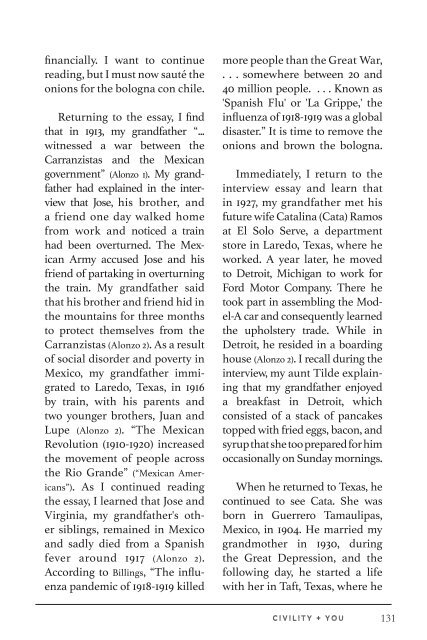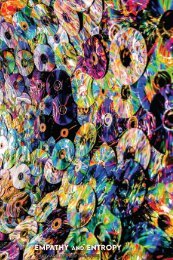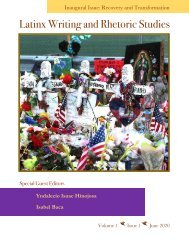Create successful ePaper yourself
Turn your PDF publications into a flip-book with our unique Google optimized e-Paper software.
financially. I want to continue<br />
reading, but I must now sauté the<br />
onions for the bologna con chile.<br />
Returning to the essay, I find<br />
that in 1913, my grandfather “...<br />
witnessed a war between the<br />
Carranzistas and the Mexican<br />
government” (Alonzo 1). My grandfather<br />
had explained in the interview<br />
that Jose, his brother, and<br />
a friend one day walked home<br />
from work and noticed a train<br />
had been overturned. The Mexican<br />
Army accused Jose and his<br />
friend of partaking in overturning<br />
the train. My grandfather said<br />
that his brother and friend hid in<br />
the mountains for three months<br />
to protect themselves from the<br />
Carranzistas (Alonzo 2). As a result<br />
of social disorder and poverty in<br />
Mexico, my grandfather immigrated<br />
to Laredo, Texas, in 1916<br />
by train, with his parents and<br />
two younger brothers, Juan and<br />
Lupe (Alonzo 2). “The Mexican<br />
Revolution (1910-1920) increased<br />
the movement of people across<br />
the Rio Grande” (“Mexican Americans”).<br />
As I continued reading<br />
the essay, I learned that Jose and<br />
Virginia, my grandfather's other<br />
siblings, remained in Mexico<br />
and sadly died from a Spanish<br />
fever around 1917 (Alonzo 2).<br />
According to Billings, “The influenza<br />
pandemic of 1918-1919 killed<br />
more people than the Great War,<br />
. . . somewhere between 20 and<br />
40 million people. . . . Known as<br />
'Spanish Flu' or 'La Grippe,' the<br />
influenza of 1918-1919 was a global<br />
disaster.” It is time to remove the<br />
onions and brown the bologna.<br />
Immediately, I return to the<br />
interview essay and learn that<br />
in 1927, my grandfather met his<br />
future wife Catalina (Cata) Ramos<br />
at El Solo Serve, a department<br />
store in Laredo, Texas, where he<br />
worked. A year later, he moved<br />
to Detroit, Michigan to work for<br />
Ford Motor Company. There he<br />
took part in assembling the Model-A<br />
car and consequently learned<br />
the upholstery trade. While in<br />
Detroit, he resided in a boarding<br />
house (Alonzo 2). I recall during the<br />
interview, my aunt Tilde explaining<br />
that my grandfather enjoyed<br />
a breakfast in Detroit, which<br />
consisted of a stack of pancakes<br />
topped with fried eggs, bacon, and<br />
syrup that she too prepared for him<br />
occasionally on Sunday mornings.<br />
When he returned to Texas, he<br />
continued to see Cata. She was<br />
born in Guerrero Tamaulipas,<br />
Mexico, in 1904. He married my<br />
grandmother in 1930, during<br />
the Great Depression, and the<br />
following day, he started a life<br />
with her in Taft, Texas, where he<br />
Civility + You<br />
131





